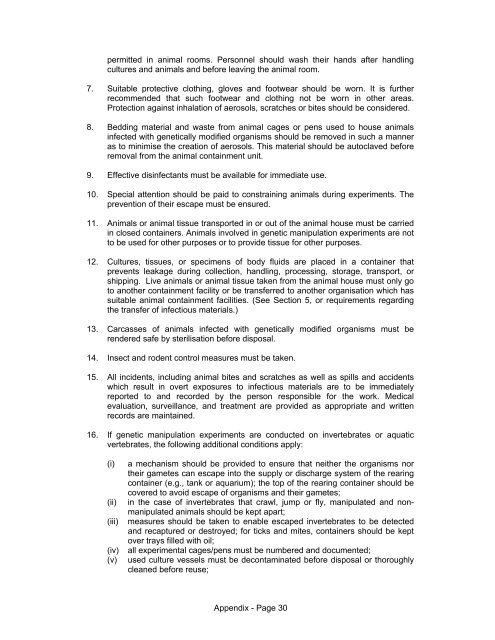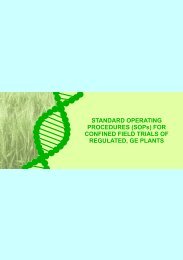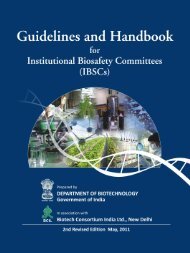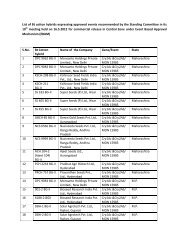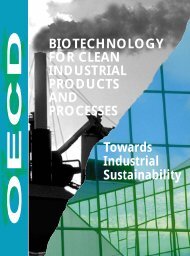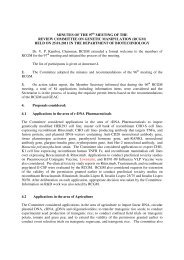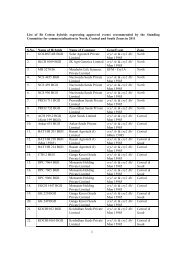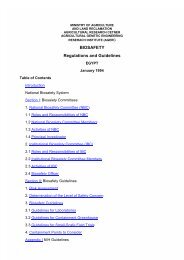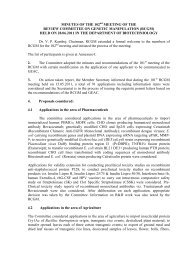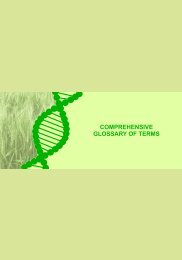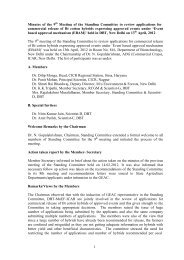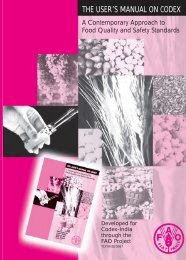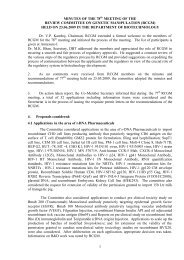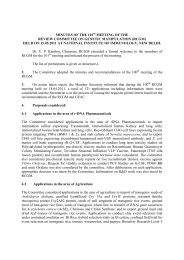Biosafety Guidelines For Research On Genetically Modified ...
Biosafety Guidelines For Research On Genetically Modified ...
Biosafety Guidelines For Research On Genetically Modified ...
Create successful ePaper yourself
Turn your PDF publications into a flip-book with our unique Google optimized e-Paper software.
permitted in animal rooms. Personnel should wash their hands after handling<br />
cultures and animals and before leaving the animal room.<br />
7. Suitable protective clothing, gloves and footwear should be worn. It is further<br />
recommended that such footwear and clothing not be worn in other areas.<br />
Protection against inhalation of aerosols, scratches or bites should be considered.<br />
8. Bedding material and waste from animal cages or pens used to house animals<br />
infected with genetically modified organisms should be removed in such a manner<br />
as to minimise the creation of aerosols. This material should be autoclaved before<br />
removal from the animal containment unit.<br />
9. Effective disinfectants must be available for immediate use.<br />
10. Special attention should be paid to constraining animals during experiments. The<br />
prevention of their escape must be ensured.<br />
11. Animals or animal tissue transported in or out of the animal house must be carried<br />
in closed containers. Animals involved in genetic manipulation experiments are not<br />
to be used for other purposes or to provide tissue for other purposes.<br />
12. Cultures, tissues, or specimens of body fluids are placed in a container that<br />
prevents leakage during collection, handling, processing, storage, transport, or<br />
shipping. Live animals or animal tissue taken from the animal house must only go<br />
to another containment facility or be transferred to another organisation which has<br />
suitable animal containment facilities. (See Section 5, or requirements regarding<br />
the transfer of infectious materials.)<br />
13. Carcasses of animals infected with genetically modified organisms must be<br />
rendered safe by sterilisation before disposal.<br />
14. Insect and rodent control measures must be taken.<br />
15. All incidents, including animal bites and scratches as well as spills and accidents<br />
which result in overt exposures to infectious materials are to be immediately<br />
reported to and recorded by the person responsible for the work. Medical<br />
evaluation, surveillance, and treatment are provided as appropriate and written<br />
records are maintained.<br />
16. If genetic manipulation experiments are conducted on invertebrates or aquatic<br />
vertebrates, the following additional conditions apply:<br />
(i)<br />
(ii)<br />
a mechanism should be provided to ensure that neither the organisms nor<br />
their gametes can escape into the supply or discharge system of the rearing<br />
container (e.g., tank or aquarium); the top of the rearing container should be<br />
covered to avoid escape of organisms and their gametes;<br />
in the case of invertebrates that crawl, jump or fly, manipulated and nonmanipulated<br />
animals should be kept apart;<br />
(iii) measures should be taken to enable escaped invertebrates to be detected<br />
and recaptured or destroyed; for ticks and mites, containers should be kept<br />
over trays filled with oil;<br />
(iv)<br />
(v)<br />
all experimental cages/pens must be numbered and documented;<br />
used culture vessels must be decontaminated before disposal or thoroughly<br />
cleaned before reuse;<br />
Appendix - Page 30


